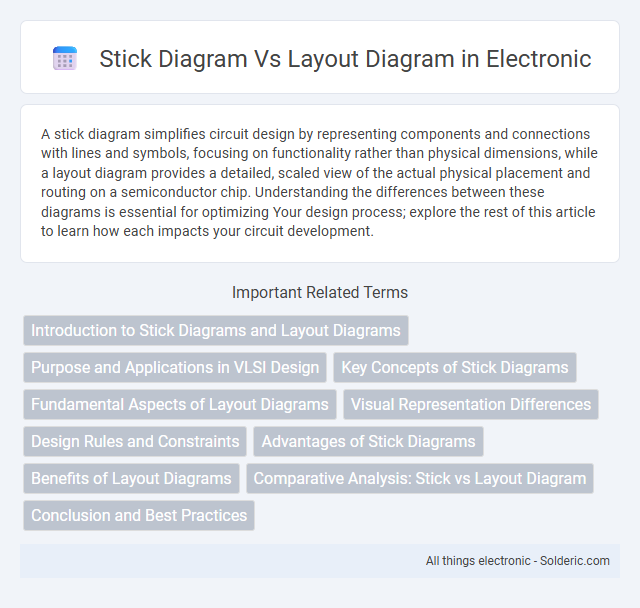A stick diagram simplifies circuit design by representing components and connections with lines and symbols, focusing on functionality rather than physical dimensions, while a layout diagram provides a detailed, scaled view of the actual physical placement and routing on a semiconductor chip. Understanding the differences between these diagrams is essential for optimizing Your design process; explore the rest of this article to learn how each impacts your circuit development.
Comparison Table
| Aspect | Stick Diagram | Layout Diagram |
|---|---|---|
| Definition | Simplified schematic representing circuit connectivity using lines and symbols | Detailed physical representation of the integrated circuit's geometric structure |
| Purpose | Visualize circuit connections quickly | Guide the fabrication process of ICs |
| Detail Level | Low; abstract and symbolic | High; precise layer and dimension data |
| Components Representation | Uses lines and basic shapes for transistors and connections | Shows exact shapes, sizes, and placements of devices and interconnects |
| Use Case | Early design phase; planning and conceptualization | Later design stages; fabrication and verification |
| Accuracy | Approximate layout and connections | Accurate, manufacturable layout details |
| Tools | Hand-drawn or simple CAD tools | Complex EDA software (e.g., Cadence, Mentor Graphics) |
Introduction to Stick Diagrams and Layout Diagrams
Stick diagrams represent circuit layouts using simplified lines and symbols to illustrate the connectivity and relative placement of components, emphasizing route planning without precise dimensions. Layout diagrams provide a detailed, scaled view of the circuit design, including exact geometries of transistors, interconnections, and layers necessary for fabrication in VLSI design. These diagrams serve distinct yet complementary roles in the integrated circuit design process, with stick diagrams aiding early-stage planning and layout diagrams guiding final implementation.
Purpose and Applications in VLSI Design
Stick diagrams serve as simplified representations of circuit layouts, emphasizing the connectivity and relative placement of components without detailing exact dimensions or layers, making them instrumental during the initial stages of VLSI design for conceptual verification and planning. Layout diagrams provide precise geometric patterns, depicting transistor shapes, interconnections, and doping regions at multiple metal layers, crucial for physical design, fabrication, and ensuring electrical performance in VLSI circuits. The stick diagram aids early-stage functional visualization and design iteration, while the layout diagram is essential for detailed manufacturing and verification processes in semiconductor fabrication.
Key Concepts of Stick Diagrams
Stick diagrams simplify integrated circuit design by representing components and connections using lines and symbols without detailed layer-specific information. They highlight vital routing paths and functional relationships between transistors and interconnects, enabling quick visualization of circuit topology. Your understanding of these key concepts aids in efficient transition to detailed layout diagrams for physical IC implementation.
Fundamental Aspects of Layout Diagrams
Layout diagrams represent the detailed physical design of an integrated circuit, capturing precise component placement, wiring paths, and layer information critical for fabrication. They include accurate geometric shapes and dimensions, enabling verification of electrical connectivity and adherence to design rules set by semiconductor foundries. Your understanding of layout diagrams is essential for ensuring manufacturability and optimal performance of the final chip.
Visual Representation Differences
Stick diagrams use simplified lines and shapes to represent circuit components and connections, emphasizing functional relationships without detailed geometric accuracy. Layout diagrams provide precise geometric shapes, colors, and dimensions, showing the exact physical placement of transistors, wires, and layers on a semiconductor chip. Your understanding of the visual differences aids in moving from conceptual circuit design to manufacturable chip fabrication.
Design Rules and Constraints
Stick diagrams simplify IC design by abstracting components as lines and shapes, allowing quick visualization of circuit topology without strict adherence to design rules. Layout diagrams enforce precise geometric constraints and design rules such as spacing, width, and layer alignment to ensure manufacturability and functionality of integrated circuits. Compliance with design rules in layout diagrams prevents errors like shorts or opens, making them critical for the final chip fabrication process.
Advantages of Stick Diagrams
Stick diagrams offer a simplified, abstract representation of circuit layouts that prioritize connectivity and routing over detailed geometries, making it easier to visualize and modify designs early in the design process. They significantly speed up the initial planning and troubleshooting phases by reducing complexity, which helps you identify potential routing issues before committing to full layouts. This efficiency lowers design iteration costs and accelerates time-to-market in integrated circuit development.
Benefits of Layout Diagrams
Layout diagrams provide a precise geometric representation of integrated circuit components, ensuring accurate fabrication and minimizing design errors. They facilitate detailed analysis of physical design rules, signal integrity, and parasitic effects, which are crucial for optimizing chip performance and reliability. This comprehensive spatial information enables designers to achieve higher density integration and better manufacturability compared to stick diagrams.
Comparative Analysis: Stick vs Layout Diagram
Stick diagrams use simple lines and symbols to abstractly represent components and interconnections, making them ideal for early-stage design and quick visualization. Layout diagrams provide detailed, exact geometric representations of circuit elements, crucial for physical fabrication and ensuring precise dimensions and spacing. You can leverage stick diagrams for conceptual planning and layout diagrams for accurate implementation in VLSI design.
Conclusion and Best Practices
Stick diagrams simplify circuit representation by highlighting connectivity without detailed component dimensions, making them ideal for early-stage design and quick communication. Layout diagrams provide precise geometrical information essential for fabrication, ensuring components meet design rules and performance criteria. Best practices involve using stick diagrams during conceptual planning and transitioning to layout diagrams for detailed design and verification to optimize accuracy and efficiency.
Stick Diagram vs Layout Diagram Infographic

 solderic.com
solderic.com